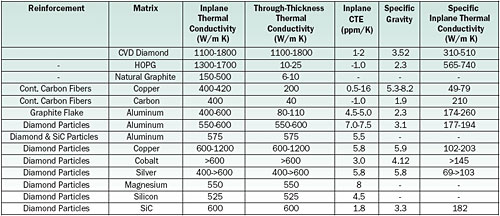Editors tend to frown on use of “revolutionary” in technical papers. However, advances in thermal management material properties in the last few years clearly warrant this word. There are now over a dozen materials with low coefficients of thermal expansion (CTEs) and thermal conductivities higher than that of copper (400 W/m K), and a score with thermal conductivities at least 50% greater than that of aluminum (200 W/m K). Most have low densities.
Thermal management has reached a critical level in microprocessor unit (MPU) packaging. For example, according to the New York Times, Intel reports running into a “thermal wall” [1]. Introduction of a pumped liquid cooling system resembling that of an automobile in the new Power Mac G5 is another illustration. In response to the problem, in the last few years there have been revolutionary materials advances. Thermal conductivities of new materials, which are at various stages of development, are as high as 1700 W/m K. Some are low cost. Others have the potential to be low cost in high-volume. Several are now in a variety of commercial and aerospace production applications. For example, in what can be considered an historic milestone, diamond-particle-reinforced silicon carbide heat spreaders are now in IBM production commercial servers.
The thermal management problem is not unique to MPUs. Other applications sharing this problem include power semiconductor modules, high-power laser diodes, high-power RF modules, high-brightness light-emitting diodes (HB-LEDs), and emerging high-power laser and RF weapons.
Advantages of advanced materials include: thermal conductivities up to more than four times that of copper; tailorable CTEs ranging from -2 to +60 ppm/K; electrical resistivities ranging from very low to very high; extremely high strengths and stiffnesses; low densities; and low cost, net shape fabrication processes. The ability to match the CTEs of a wide range of materials, such as silicon and printed circuit boards, enables reduction of thermal stresses, distortion and warping.
The payoffs are: improved and simplified thermal design; reduced thermal stresses and warpage; increased reliability; improved performance; weight savings up to 90%; size reductions up to 65%; increased manufacturing yield; and potential cost reductions.
High-performance advanced packaging materials fall into five main categories: monolithic carbonaceous, such as natural graphite and highly-oriented pyrolytic graphite (HOPG); metal matrix composites (MMCs); carbon/carbon composites (CCCs); ceramic matrix composites (CMCs); and polymer matrix composites (PMCs) [2,3].
Table 1. Properties of Advanced Materials with High Thermal Conductivities and Low Coefficients of Thermal Expansion (300 ≤ k < 400 W/m K)
(Aluminum, copper and copper/tungsten shown for reference.)
 |
For convenience, we break down high-performance materials into two categories: those having thermal conductivities of 300 to 399 W/m-K, which we call high-conductivity (Table 1), and those having thermal conductivities of at least 400 W/m K, which we call ultrahigh-conductivity (Table 2). All of these materials have low CTEs, some of which are tailorable. Properties presented include thermal conductivity, CTE, density (as specific gravity) and specific thermal conductivity, a term we introduced many years ago, which is defined as thermal conductivity divided by density. This is a useful figure of merit when both weight and thermal conductivity are important [4]. For simplicity, we use the dimensionless specific gravity, which has the same numerical value as density when the latter is expressed in g/cm3. Using this approach, thermal conductivity and specific thermal conductivity have the same units, W/m K. The tables include aluminum, copper, copper/tungsten and CVD diamond (diamond made by chemical vapor deposition) for reference. For anisotropic materials, we present inplane and through-thickness values.
Table 2. Properties of Advanced Materials with Ultrahigh Thermal Conductivities and Low Coefficients Of Thermal Expansion (k ≥ 400 W/m K)
 |
Although some of the materials shown in the table may not succeed, it is highly likely that a number will become the materials of choice in the 21st century.
We are in the infancy of thermal management materials technology. Undoubtedly, better and cheaper materials and processes will continue to emerge.
References
- Markoff, J., “Intel’s Big Shift After Hitting Technical Wall”, New York Times, May 17, 2004.
- Zweben, C., “High Performance Thermal Management Materials”, ElectronicsCooling, Vol. 5, 1999.
- Chung, D. D. L., and Zweben, C., “Composites for Electronic Packaging and Thermal Management”, Comprehensive Composite Materials, Kelly, A., and Zweben, C. Eds., Vol. 6: Design and Applications, Pergamon Press, Oxford, 2000.
- Schmidt, K. A., and Zweben, C., “Advanced Composite Packaging Materials”, Electronic Materials Handbook, ASM International, Materials Park, Ohio, 1989.






